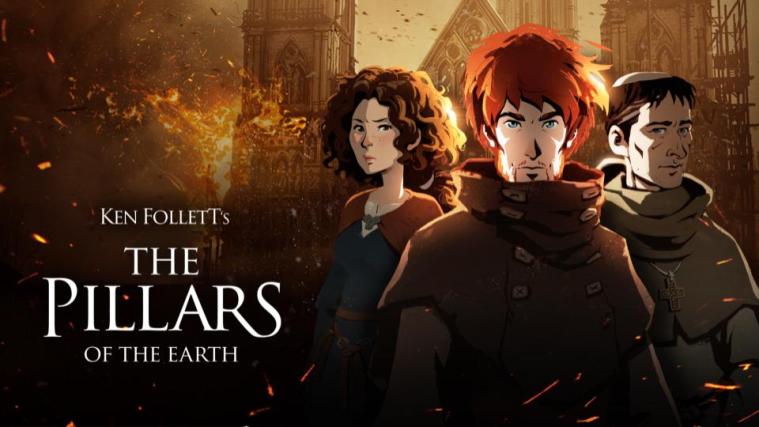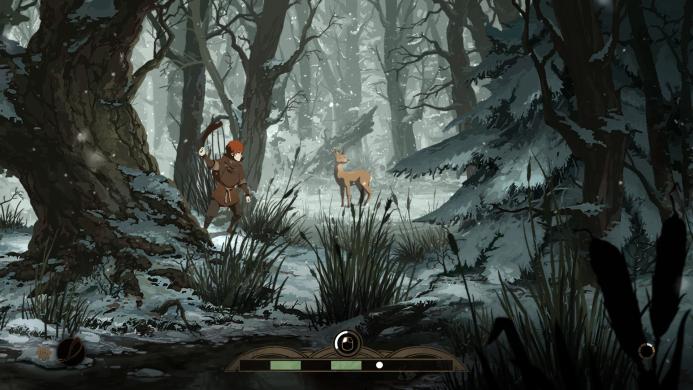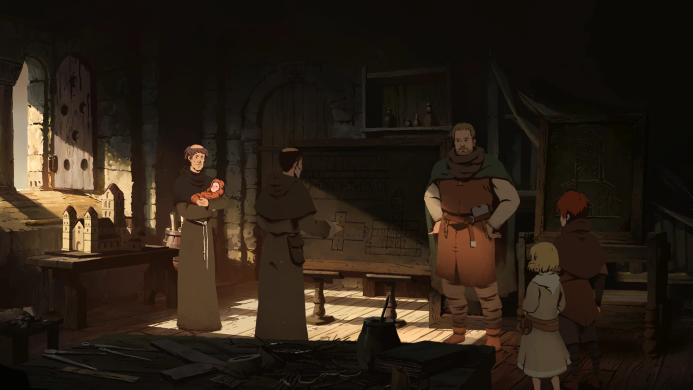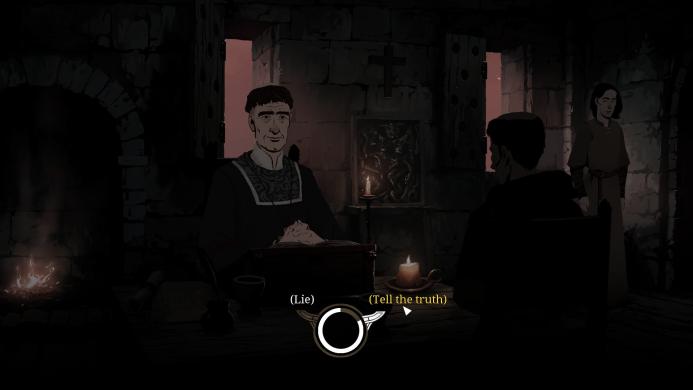It’s been quite a while since I played a new game out of total spontaneity, but this particular title caught my attention when it was a free giveaway on the Epic Games Store with a monk on the cover. Yea, it’s pretty easy to clickbait Catholics… What followed was a very interesting journey of highs and lows, but most of all some reflections which I simply cannot abide holding back any longer.

Developed and published by Daedalic Entertainment, The Pillars of the Earth is a point-and-click adventure drama released episodically in 2017 and 2018 for PC, Playstation 4, Xbox One and mobile. This is a review of the PC version. The premise involves stepping into the role of three main protagonists Brother Philip, Jack, and Lady Aliena, and following their turbulent lives centered around the fate of the fictional 1100’s English priory of Kingsbridge and its cathedral. Players interact with the game by making dialogue choices in conversations and exploring areas to solve puzzles to advance the narrative.
Bear in mind that this game is based on a 1989 novel of the same name by Ken Follett, and in fact the game’s full name technically includes the author’s name. I however, being the filthy 21st century schlub I am, was not aware of this when I first started playing and did not read the book afterwards. This review will be written purely off my personal experience and not as a comparison piece.
The story of The Pillars of the Earth is probably the best place to start, as an adventure game isn’t all that fun without some breadcrumbs worth following. Starting in 1135 at the town of Kingsbridge, Brother Philip travels to the town’s priory shortly after the unexpected death of its prior and gets involved in the religious community’s affairs at the behest of his brother and fellow monk Francis, unwittingly getting tangled in the larger politics of England. Additionally a young boy named Jack and his outlaw mother in the woods cross paths with the aptly named family of Tom Builder and fatefully return with them to civil society. They are the ones to encounter the Lady Aliena of Shiring, whose noble status meets a violent disruption. All of these characters eventually find a stake in the maintenance of Kingsbridge’s cathedral and various trials ensue over the course of their lives. On the whole I found the plot to be enjoyable, with its shifting perspectives keeping the flow of events varied and interesting. While I ultimately found more fulfillment in some protagonists over others (Lady Aliena’s story was my personal favorite), none of them failed to capture my investment and I cared when things got heavy. I did find some major underlying issues in the story of Brother Philip though, and I mean the sort of stuff that left me awake in bed in feverish reflection about it at night, and it is probably the main point of concern for interested Catholics. However for me to explain this to my satisfaction I need to discuss basically the whole broad strokes of the story plus some details, so I’m going to include a lengthy spoiler filled discussion below the review. To state it as best I can here though, I think there have been stories far more mean-spirited against the Catholic Church and there is some genuinely resonant stuff in its conclusion, but this is ultimately a story written by an atheist and there are some patterns and messages that make the journey to that conclusion intensely suspect.
Of course one needn’t look to the finer details of the story to heed the M-rating, because there is plenty of content that might dissuade one from playing. This game definitely takes cues from modern television because it is not afraid to get ugly. Characters get stabbed and die bloody deaths, a few characters make liberal use of the foulest expressions, basically everything related to William Hamleigh is repugnant on several levels, and even a couple of rather ertoic scenes occur, thankfully at least with no visible nudity. I’m not one to police my audience too much but for The Pillars of the Earth in particular I implore you, follow the rating guidelines and only go in prepared for some dark content.
The gameplay of this title is fairly simple. The world is navigated entirely through mouse clicks, be it movement, object interaction, or conversation. Interactivity comes mostly from listening to what characters are saying and scouring the area for the items and information that will allow the characters to manipulate the environment, or persuade others, into pushing the story forward. Once you’ve explored a little it doesn’t become that hard to figure out what to do at any given point, but there was the occasional puzzle or side puzzle that was satisfying to finally figure out. There’s also a few quick time events to represent particularly fast, precise, or laborious actions which I didn’t mind but I could see being annoying for some players.

The other half of the gameplay involves selecting dialogue options during conversations, or sometimes selecting nothing and staying silent. The heavy inclusion of these dialogue choices really help to immerse you in the story and facilitate conversation based puzzles, however this also might create some expectations in the player (myself included at first) that this could lead to major branching narrative events. While it is true that you can affect whether certain characters live or die, the overall trajectory of events remains unchanged. This is where one needs to be reminded that at its core The Pillars of the Earth is not a visual novel or interactive cinema, but a point-and-click adventure game. While the use of mechanics associated with narrative influence does have some plausible criticism for not taking more advantage of the medium of video games, I respect its actual genre definition enough that I won’t personally dock it too much. Overall the gameplay serves its purpose but is more a facilitator of interaction with the game’s story and presentation.
The presentation definitely deserves that spotlight too. The game achieves its visual style by combining two dimensional hand drawn backgrounds with three dimensional models, but crafting the models to look as two dimensional as they could. Once I learned how to see the three dimensional features of the models it was pretty easy to notice, but it took me a while to actually train myself to do so, and when I wasn’t focusing on that I hardly noticed at all. Games that achieve this look rank decisively as some of the best looking games ever made, and The Pillars of the Earth definitely earns its spot among that number. There’s a sort of serenity to the artstyle which not only emphasizes the beauty of the world and accentuates the game’s quieter moments, but also makes intense scenes feel more like an intrusion on the peace. If I had one complaint it’s that I wish there were more facial expressions drawn for the main cast so that watching them talk didn’t become quite so repetitive at times.

The graphics are complemented by all of the dialogue in the game being fully voice acted. The script is pretty well written, the acting is authentically British, and it adds a lot of color to even simple tasks. One of the first things I discovered was that you could select Brother Philip’s Bible and then anything or anyone in the environment to get related scripture or faithful comments fully voiced by the actor, and I was positively giddy with delight at this addition (asterisk in the spoiler section). As for the game’s soundtrack, it’s used pretty well when it is present, but most of your playtime will actually lack any music in the background in favor of ambience and as a result the score struggles to produce any real notable songs.
So in conclusion, is The Pillars of the Earth worth playing? The answer definitely changes depending on your tolerance for dark content and having enough spiritual maturity to understand that what it depicts of our faith is by no means a particularly accurate examination. If you possess both of these however, I think it’s worth playing for its great production value and engaging character arcs alone. If a story-driven adventure is what you’re in the mood for, it’s a fine choice. Just don’t play it on a bad day.
Scoring: 72%
Gameplay: 4/5
Art and Graphics: 5/5
Music: 3/5
Story: 4/5
Replayability: 2/5
Morality/Parental Warnings
As mentioned in the review, The Pillars of the Earth features graphic violence, foul language including quite a number of f-word drops, and a sex scene between an umairried couple with very little shown. There’s also a few scenes wherein rape is explicitly threatened, and even a set of prostitutes in one section. The Catholic clergy are depicted anywhere from upstanding and likable, to holding some heretical beliefs, to downright cartoonishly evil, which overall makes some sense given the historical setting but is worth pointing out. There are three scenes in which certain characters have demonic visions. Players are sometimes made to take saliently morally questionable actions in order to advance through the game, such as holding a man to a knife’s point (even if he was a pretty bad dude).
If you enjoyed this or any other review on Catholic Game Reviews, kindly consider supporting our efforts over on Patreon. Special benefits like exclusive sticker merch, Discord access, and game review recommendation are available in exchange for consistent monthly donations. Thank you for any help you give us in pursuit of exploring the world of games through the Catholic lens.
Where is God?: A Study of the Narrative Themes and Character Arc of Brother Philip
Note: The following section broadly spoils roughly one-third of the game’s events, from beginning to end.
Ubi caritas et amor, Deus ibi est. This short phrase is the text for my favorite chant sung each year around Easter and it translates to “Where love and charity abide, God is there.” This is a truly important lesson to remind ourselves that sometimes God’s miracles come not in the form of grand displays of divine radiance, but in the simple act of uniting our will to Him and doing good to others. You might be surprised to hear that The Pillars of the Earth’s final scene ends with this as one of Brother Philip’s final words to the audience. “I thought I had lost God. That He did not watch over us. But now I see Him every day. He is in the good we do. In how we show our love.” But when I heard this for the first time in-game I wasn’t able to take the happiness I should have had in hearing it. Allow me to show why that is. First I’ll do a recap of Philip’s mental state for the unfamiliar by broadly touching upon the most significant events that drove his downfall through the narrative, and then I’ll explain how the game’s messages drive towards very questionable grounds.
At the beginning of the story, Brother Philip is a righteous monk who cares for the well-being of others and has a strong faith, but also has written into his character both a stubbornness in accomplishing his goals and a difficulty saying no to people, which is how he simultaneously genuinely desires to help the priory of Kingsbridge while also getting involved in helping his brother Francis with his political affairs and eventually getting elected the new prior of Kingsbridge. This brings me to my biggest technical criticism with the game’s handling of Philip, where the actions he takes at any given time feel like the writers leverage one of these two contradictory character traits at any given time in order to get Philip where the plot needs him to be. While you are able to influence what Philip says in the conversations in order to lean into one of these traits more, it ultimately matters very little since if he himself doesn’t eventually capitulate to one character trait in order to make something happen, the story will find a way to get him there anyways. Try not to involve yourself in Francis’ mission and he guilts you into it, try not to enter a deal with Regan Hamleigh and she’ll pretend you did make the deal while you lose your voice in front of King Stephen. While I think these events do serve to illustrate how much influence the scheming earls and corrupted bishops have over the lives of those below them, it came at the cost of granting Philip any real degree of consistent characterization and felt very forced.

All this political weight on the man’s shoulders takes its toll on him, and at the beginning of the second act we see as the rebuilding of the destroyed cathedral begins, Philip too begins constructing divisions between him and the Church by questioning their authority on the basis of trials by fire and the like in books he writes, which isn’t even historically accurate because most of said trials were due to the government in real life. Things finally come crashing down on Brother Philip when he witnesses the horrors at the battle of Lincoln and decides that neither God nor the devil has any sway over human affairs and that it’s “only us.” From here I did my utmost to roleplay Brother Philip’s actions into being as pious as possible to the point of using game guides, but at best I could make him out to be a monk deeply struggling with the Problem of Evil (I’ll wait for you to finish rolling your eyes). Even that “Bible comment on demand” feature I mentioned in the review becomes the “depressed cynicism on demand” feature. As a side note perhaps the most flagrantly contrived event in the whole story happens around this time too. When Brother Philip confides in the wonderfully devout Brother Millius about his waning faith, Millius promises to help only for Millius to die in the exact same chapter trying to protect the remains of a fictional saint and plunge Philip further into despair.
Act three opens up somehow even worse than where two left off despite the time jump, with Brother Philip writing a book promoting full-on gnostic Divine Spark heresy and him accepting into the cathedral a fake Weeping Madonna he knows is fake but would rather it serve the purpose of giving visitors hope and funding the re-reconstruction of the cathedral (giving people false hope by lying to them is easily one of the most disgusting sins I think a person can commit). Fortunately the player is given one last opportunity to push his characterization towards something more positive by pleading guilty at his trial, though I’d argue it should have been mandatory in order to better flow from the conclusion of the trial to the game’s epilogue. After this point the game skips ahead several years for its epilogue and this is where a lot of the interpretive element of the closing lines comes into play. There are other plot points in Jack and Aliena’s stories that might also matter and this is a grossly brief summary of the events of Philip’s journey that leaves out a lot of the events which probably add nuance (like for example the scene at the bridge during the attack on Kingsbridge where despite the terrible things that are happening you can have Philip reject the use of a herbal sedative in favor of reading scripture to calm someone down), but for those who haven’t played the game I wanted to communicate exactly what sort of tribulations fell upon the protagonist and the mistakes he made because of them.
So then, on an optimistic reading of the game’s story, the epilogue dialogue points to the fact that despite the horrible tragedies that happened in the story, God had been by the protagonists’ sides providing them with the graces they needed to endure and forge a better world as we understand Him to do for us in reality. However, this is not the interpretation I think was intended by the writer. The main basis of this hypothesis stems from how the story handles supernatural events, both divine and demonic. In the case of the divine there are two miraculous events, those being the “Weeping Madonna” and Philip’s trial by fire ending with the flames suddenly going out. The audience is very clearly informed that both of these are completely man-made and have material explanations, even if in the “Madonna’s” case they aren’t entirely sure how it works. They are called miracles only because those not in on the trick believe them to be miracles. In the case of the demonic there are three cases of someone seeing visions of the devil, twice by William Hamleigh and once by Brother Philip. At first I struggled to understand why the two most different characters in the story would suffer the same visions, but the major difference between the visions is that in Brother Philip’s case his vision ends when he abandons belief in the supernatural. I have concluded that these visions are supposed to represent believers suffering from demons of their own making rather than there being any real demons to hurt them (Oh and quick disclaimer, William only believes insofar as he can ‘abuse’ the Sacrament of Reconciliation to commit further atrocity with a somewhat clearer conscience, and to some extent I think the vision of the devil he sees as he’s dying is supposed to be cathartic in that the viewer is allowed to imagine him in agony at the thought of going to Hell. I didn’t find it all that cathartic).
There’s the issue of what we don’t see as well, namely that the story time jumps from the end of Philip’s trial to the epilogue. The only thing that we really learn about how life has changed for him is that he returned to be the prior of the monks he led before the events of the story started, so we’re left with a lot of questions behind the context of the peace he found. Did he slowly return to faith in God properly and see things the way the optimistic reading does, or does he take comfort in the heretical idea that God lies as a divine spark inside every man and that is what he means by seeing God every day? I honestly can’t tell you either way. So you combine the divorce of good and evil from their greater spiritual contexts with a story that portrays the hard work and effort of its protagonists as very positive and integral to the resolution of conflicts, and add a dash of ambiguity to Brother Philip’s internal resolution, it seems as though the player is encouraged to look at Brother Philip’s words and say “why not take it a step further and say that it is truly humanity alone that bears goodness and love to one another?” This sort of thinking isn’t exclusive to this story either, as sometimes I’ve wondered about the Ubi Caritas and whether or not it is an easy chant to turn against the Church with one simple shift in perspective.
Yet after all of these signs against Christianty in the story, much like the worries I had with the Ubi Caritas, I still cannot bring myself to say that it isn’t possible to read these in a positive light. Believe it or not I ultimately found Brother Philip’s story as the second best in the game, and little moments of positivity went a long way in giving the more optimistic reading some credibility. Plus the part I mentioned about the characters’ hard work being portrayed positively is perfectly compatible with our understanding that God helps the world through both our prayers and our actions alike (see St. Teresa of Avila’s “Christ has no body but yours”). Death of the author isn’t a literary practice I am entirely at peace with, but I do think that The Pillars of the Earth can be understood from the Christian perspective of the struggles against sin and triumph through faith. Whether you embrace this interpretation or not I leave to you in your discernment of whether this game is worth sharing or condemning, but I’ll leave off on this reminder: No matter what trials may come into our lives and how hopeless things seem to get, if we keep our faith alight and persevere in our missions, God will work through the efforts of the faithful to rescue our hearts no matter what.
Ubi caritas et amor, Deus ibi est.
